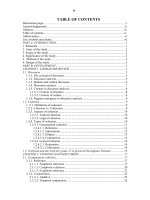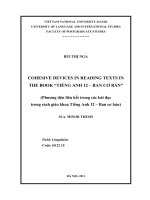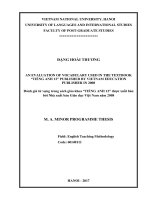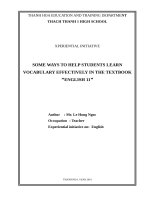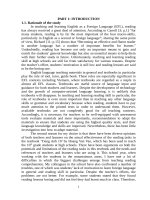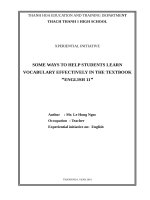Cohesive devices in reading texts in the textbook “Tiếng Anh 12 – Ban Cơ Bản
Bạn đang xem bản rút gọn của tài liệu. Xem và tải ngay bản đầy đủ của tài liệu tại đây (164.79 KB, 7 trang )
Cohesive devices in reading texts in the
textbook “Tiếng Anh 12 – Ban Cơ Bản
Bùi Thị Nga
Trường Đại học Ngoại ngữ
Luận văn ThS. Chuyên ngành: English Linguistics; Mã số: 60 22 15
Người hướng dẫn: Nguyen Thuy Phuong Lan, MA.
Năm bảo vệ: 2011
Abstract: The study aims at finding out the grammatical and lexical cohesive devices in
the textbook “Tiếng Anh 12” for grade 12 students in general throughout Vietnam. The
reason for choosing grammatical and lexical cohesion as the main objects of the study
lies in their popularity in linguistic fields and the tests for examinations at upper
secondary schools these days. In this paper, some theories of discourse and cohesion
leading to the basic background for the study are discussed. According to that, the theory
of cohesive devices by Halliday and Hasan (1976) is the major framework. Besides, the
source of the study is reading texts; hence, features of written discourse are necessary
base to characterize the study. Throughout investigating 16 units in the textbook, the
author found out that the most prominent cohesive device is collocation, then
conjunctions, reference and repetition. It was suggested that during the process of
teaching, teachers should instruct students in understanding and employing these
cohesive devices correctly.
Keywords: Bài đọc; Sách giáo khoa; Tiếng Anh; Lớp 12
Content
PART A: INTRODUCTION
1. Rationale
In the interconnected and globalized world nowadays, knowing English is of great importance.
That forces students, especially high school students, to have to equip themselves with the basics
of English, so that they can enter the world more easily, and to some extent, better their future
life. To grade 12 students, this is more essential. Not only do they need English in the future, but
in the nearer view English is one of the core subjects in the GCSE examination, and the entrance
examination to university.
Tracing back to these two national examinations recently, the high occurrence proportion of
cohesive devices can not be denied. In my observation, except for phonetic parts, cohesive
devices, along with their usage and meaning, are useful tools in both reading texts, and many
sentences in such parts as writing, mistake correction, and multiple choice questions. That is to
say, the teaching of cohesive devices is essential to grade 12 students.
Moreover, on the process of mastering language in general, English in particular, to Vietnamese
secondary students, reading is seen as the crucial tool that aids the learning of the other skills.
However, it is a fact that, these days, many high school students do not have adequate linguistic
knowledge to read and understand a whole written text in English. During my process of
teaching high school students, I come to realize that one of the foremost reasons for which
students often make errors at sentence and discourse levels is due to their inattention to the
cohesive devices used in the context of texts. What they do is to try to look up new words, and
then translate the texts into Vietnamese. As a result, students find it hard to understand the text or
express their answers in the comprehension check questions even though they know most of the
words. Those who are given in advance unfamiliar words still show their inability in recognizing
sentences, and word relations, which leads to the misunderstanding or misinterpretation of the
meaning of the texts.
In addition, according to my past experience of being a final-year student at high school, as well
as during my observation at my working place, most of the teachers, both my former ones and
my present colleagues, do not teach students how to realize word relations through the cohesive
devices.
Apart from a variety of mentioned things, many people have done researches on linguistics and
discourse analysis; yet, no suggestions have been given to high school teachers and students so
that they can do tasks relating to cohesion more successfully. Consequently, the decisive
motivation in doing this research derives from the extremely important role of cohesion in the
text and also the difficulties of my students who lack the ability to make proper recognition of
cohesive devices in written texts in their textbooks. This research spends a large part looking
closely at grammatical and lexical cohesive devices, under the theory of cohesion by Halliday
and Hasan (1976), used in the textbook for grade-12 students in general in terms of the frequency
of occurrence
2. Aims of the study
While carrying out this research, the researcher, firstly, attempts to describe and analyze
cohesive devices in the English textbook for grade 12 students in general throughout Vietnam in
term of grammar and lexis. Then, the research aims at giving some implications for teaching
cohesion, as well as certain sample cohesive exercises for designing material for the revision of
GSCE examination and the entrance examination to university. Finally, by doing this study, the
researcher hopes to indicate striking features of cohesive devices so as to help students
understand the reading texts more effectively.
The following research questions are raised for exploration while carrying out the study:
1. What are the cohesive devices used in the textbook “Tiếng Anh 12 – Ban Cơ Bản” for
grade - 12 students general throughout Vietnam?
2. How can the findings help teachers and their students in the teaching and learning the
textbook for grade 12 students?
3. Scope of the study
Within the limited time and knowledge, only grammatical and lexical cohesion in the textbook
“Tiếng Anh 12” for grade - 12 students general throughout Vietnam edited by Hoang, V.V et al
(2010), Education Publication House are observed. Furthermore, the study does not propose all
the possible solutions to teaching and learning cohesion but only some implications that are
directly drawn from the textbook observation and the observation of the tests for GSCE
examination and the entrance examination to university over the past few years. Only two skills,
reading and writing, are chosen to present.
4. Significance of the study
Theoretical significance: The study brings with it the task to verify the correctness and
significance of linguistic theory by working on the discourses of different issues in social life
mentioned in the researched textbook. It is hoped to prove the existing ideas on cohesion to
satisfy the individual’s question and, to some extent, hopefully to open a new way of revising
and preparing for candidates of the GCSE examination and the entrance examination to
university.
Practical significance: This research gives out some practical applications, such as
combining linguistic theory and practice in analyzing written English discourses in the
researched textbook. In addition, the researcher hopes to give teachers and students a hand with
teaching and learning cohesion through reading and writing skills.
5. Method of the study
Approaches and methods
The study can not reach its final page without a logical system of approaches and methods. Both
qualitative and quantitative approaches are applied. However, the latter is exploited most of the
time. The tackling methods are statistic and descriptive (getting the statistics from the texts in the
chosen textbook), analytical and synthetic (drawing striking features from the book observation).
Firstly, a number of materials on discourse analysis are discovered to give the research a
theoretical base. Then, it is ensured that none of the most noticeable cohesive devices in the
reading texts in the textbook for intermediate students at grade 12 is missed their analysis and
induction. Finally, the results are drawn out so that the author can suggest some implications.
Data collection and analysis
The grammatical and lexical cohesive devices to be studied will be taken from the textbook
“Tiếng Anh 12” for grade 12 students at intermediate level edited by Hoang,V.V et al (2010),
Education Publication House.
6. Design of the study
The thesis capacity is within 40 pages, structured as follows:
Part A: Introduction introduces the rationale, objectives, scope, significance, methodology and
the design of the study.
Part B: Development
Chapter 1: Literature review deals with the theories related to Discourse and Discourse
Analysis, cohesion, and the textbook.
Chapter 2: Findings and discussion of textbook observation analyses cohesive devices in the
reading texts in the textbook for intermediate grade 12 students, basing on the view of Halliday
and Hasan (1976)
Chapter 3: Pedagogical implication of the study gives implications for teaching and learning
cohesion basing on reading and writing skills.
Part C: Conclusion aims at summarizing the thesis by showing the study results and giving
concluding remarks. Some suggestions for further studies are also included to promise the
continuance of the author’s future work.
REFERENCE
ENGLISH
Brown, G. and Yule, G. (1983). Discourse Analysis. Cambridge: Cambridge University
Press.
Carthy, M.M. (1991). Discourse Analysis for Language Teachers. Cambridge: Cambridge
University Press.
Cook, G. (1989). Discourse. Oxford: Oxford University Press.
Crystal, D. (1992). Introduction to linguistics. London: Penguin.
Cunningsworth, A. (1995). Choosing your course-book. Oxford: Heinemann.
Eggins, S. (1994). An Introduction to Systemic Functional linguistics. London: Continuum
International Publishing Group.
Halliday, M.A.K. & Hasan, R. (1976). Cohesion in English. London: Longman.
Halliday MAK & Hasan R., 1989. Language, Context and Text: Aspects of language in a
socio-semiotic perspective. Victoria: Deadkin University Press. London: Longman group
Limited.
Halliday, M.A.K. (1994). Functional Grammar. London: Edward Arnold.
Hoàng, Văn Vân. (1999). Introducing Discourse Analysis. Hanoi: Education Publishing House.
Nguyễn, Hòa. (2000). An Introduction to Discourse Analysis. Hanoi: Vietnam National
University Publishing House.
Hutchinson, T and Torres, E (1994). The textbook as agent of change. ELT Journal, 48(4), 315-
328.
Nunan, D. (1993). Introducing Discourse Analysis. London: Penguin.
Paltridge, B. (2006). Discourse Analysis: An Introduction. London: Continuum International
Publishing Group.
Richards, J. C. et al (1998). Longman Dictionary of Language Teaching and Applied Linguistics.
London: Longman.
Salkie, R. (1995). Text and Discourse Analysis. London: Routledge Publisher.
Schiffrin, D. (1994). Approaches to Discourse. Oxford: Oxford University Press.
Sheldon, L. E (1988). Evaluating ELT textbooks and materials. ELT Journal 42(4). 237-246.
Telemans, G. (2001-2002). Discourse Analysis. Hanoi: VNU Press.
Thornbury, S. (2006). An A-Z of ELT: a dictionary of terms and concepts used in English
Language Teaching. Macmillan Education.
Yule, G. (1996). The Study of Language. Cambridge: Cambridge University Press.
Widdowson, H.G. (1979). Pragmatics. Oxford: Oxford University Press.
Widdowson, H. G. (1984). Explorations in Applied Linguistics 2. Oxford: Oxford University
Press.
VIETNAMESE
Bộ Giáo Dục và Đào Tạo. (2006). Tài Liệu Bồi Dưỡng Giáo Viên Môn Tiếng Anh . Nxb Giáo
Dục, Hà Nội.
Bộ Giáo Dục và Đào Tạo. (2010). Chương trình Giáo Dục Phổ Thông: Môn Tiếng Anh. Nxb
Giáo Dục, Hà Nội.
Hoàng Văn Vân (Chủ Biên). (2010). Tiếng Anh 12, Sách Giáo Viên. Nxb Giáo Dục, Hà Nội.
Trần Ngọc Thêm. (2000). Hệ Thống Liên Kết Văn Bản Tiếng Việt. Nxb Giáo Dục, Hà Nội.
Vũ Thị Lợi & Nguyễn Hữu Châu. (2010). “Hướng dẫn thực hiện chuẩn kiến thức kĩ năng môn
Tiếng Anh trung học phổ thông.” Nxb Giáo Dục, Hà Nội.
